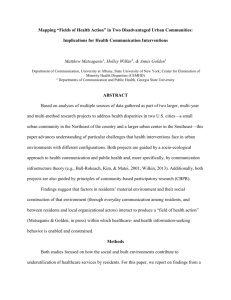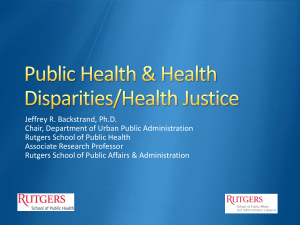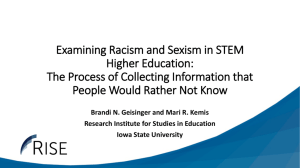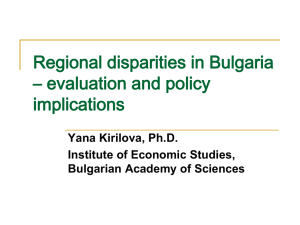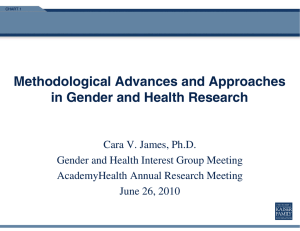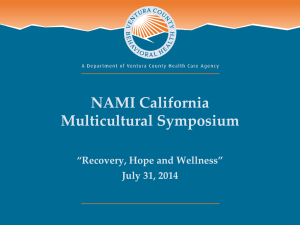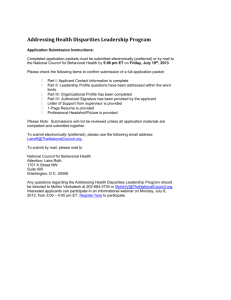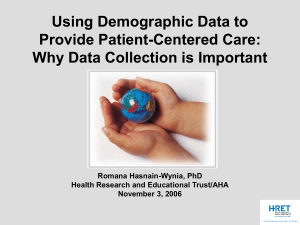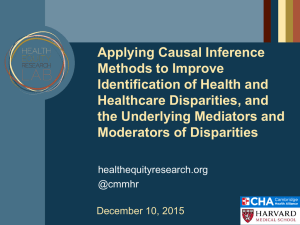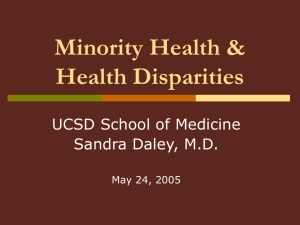The Promise of Naming & Moving Research & Action
advertisement
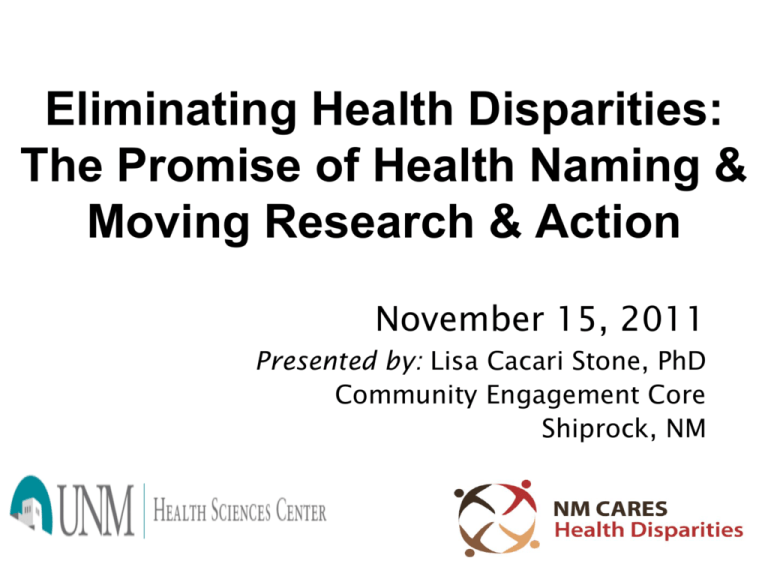
Eliminating Health Disparities: The Promise of Health Naming & Moving Research & Action November 15, 2011 Presented by: Lisa Cacari Stone, PhD Community Engagement Core Shiprock, NM Health Disparities in New Mexico • Hispanics had the worst rates on 4 indicators (teen births, chlamydia, adults 65+ not receiving a pneumonia vaccination, drug induced deaths). • American Indians fared the worst on 7 indicators (prenatal care, diabetes deaths, overweight among youth, pneumonia & influenza deaths, motor vehicle deaths, youth suicide, alcohol related deaths). • African-Americans fared the worst on 4 indicators (infant mortality, adult obesity, HIV/AIDS, homicide). • Whites had the highest rates on 3 indicators (suicide, individuals with diabetes not receiving preventive services, pertussis). • Asian/Pacific Islanders had the highest rate on 2 indicators (hepatitis B and smoking). “A Pair of Shoes” for the Journey Health Disparity “…differences that occur by gender, race, ethnicity, education or income, disability, living in rural localities or sexual orientation.” Healthy People 2010, USDHHS “…differences in the incidence, prevalence, mortality, and burden of diseases and other adverse health conditions that exist among specific population groups in the U.S. Research on health disparities related to socioeconomic status is also encompassed in this definition.” National Institutes of Health (2000) Carter-Pokras, O. & Baquet, C. What is a "health disparity"? Public Health Rep. 2002 Sep-Oct; 117(5): 426–434. Health Equity • Equity in health is the absence of systematic disparities in health (or in the major social determinants of health) between groups with different levels of underlying social advantage/disadvantage—that is, wealth, power, or prestige. Braveman, P. & Gruskin, S. Theory and methods Defining equity in health. J Epidemiol Community Health 2003;57:254-258 How Communities Name “it”? • Community Knowledge & Lived Experiences – Community naming “what matters?” in health – Disparities?; Equity?; Selfdetermination? – Problem or solution based? – Sustainability of land? Food? Water? The Promise of Research to Eliminate Health Disparities There has been a historical interplay between research, policy and social activism. Research to Action • Serving as a change agent • Providing education and leadership training • Moving to multi-level interventions (community, systems & policy) Detecting Define & measure HD & vulnerable populations Understanding Identifying Determinants of HD: •Patient/individual •Provider •Clinical encounter •Health care system •Public policies •Social sources Reducing/ Eliminiating Intervene Evaluate Translate & disseminate Change policy UNM Health Science Center’s Growing Research Funding Growth of UNM HSC Research Funding Compared to Growth of NIH Research Funding FY10: $142 Million 600% 550% UNM HSC Research Funding (Percent of 1993 Dollars) 500% UNM 450% 400% 350% 300% NIH 250% 200% 150% 100% 1993 1996 1999 2002 2005 2008 • $142 Million in FY10 • Growing while other universities are declining • $72 Million in salary compensation in public sector in NM (non-state dollars) • 816 sustained jobs in private industry in NM Community-Based Research • Expand research on health disparities interventions • Expand the number of researchers in health disparities interventions • Build community partnerships dedicated to research on health disparities and provide technical support • Eliminate health disparities in minority populations Goal - to access and build public trust and engage NM communities as equal partners in the conduct of research that informs effective health disparity interventions Activities/Strategies •Create partnerships between researchers and community constituencies for defining disparities research agenda •Assess barriers & facilitators to community engagement, and develop action strategies to enhance trust & partnership • Develop Intercultural Health Disparity Scholars and Summer Trainings • Translate & disseminate findings to enact practice, policy interventions, community capacity and programs • Utilize Community Liaisons to build linkages and bidirectional outreach and in-reach to identify Health Disparity research priorities • Work with the Community, Scientific Advisory Council (CSAC), Health Science Center (HSC) NM CARES HD leadership on strategic planning • Outreached & recruited CSAC members • Organized & facilitated first CSAC Bi-annual Meeting and produced summary report with recommendations • Coordinate ongoing bi-annual meetings Themes for Action 1. Coordinate Intra-Institutional Communications 2. Address the Institutional Practices that Discourage Support of the Institution by the Community 3. Make the Community an Equal Partner 4. Eliminate rather than manage Health Disparities 5. Identify Best Practices 6. Increase Minority Faculty
